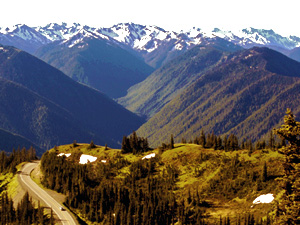
The road to Hurricane Ridge in Olympic National Park
Washington’s Olympic National Park is 1,441 sq. miles and includes miles of coastal beaches, old growth forests and glacial mountain peaks. Because of its old growth woodlands, the park serves as a refuge for many endangered species. It is one of the last large tracts of primeval forest in the lower 48 states.
In 1897, this beautiful park became the Olympic Forest Reserve. Later, because less than 200 of the area’s native elk herd remained, Teddy Roosevelt made it a national monument in 1909 to protect these animals. The elk then became known as Roosevelt elk. Finally, in 1938 Congress made it a national park.
At the heart of this magnificent park are most of the Olympic Mountains, with the 7,965 ft Mount Olympus at the center. Winds off the Pacific bring the western slopes of the mountains over 160 inches of rain a year, and averages of 250 to 500 inches of snow in the winter. Because of this, there are over 260 glaciers in the park’s mountain peaks. Olympic National Park offers visitors distinctive geography created by glaciers, lush rainforests, and many hiking and camping opportunities.
More information on Olympic National Park.
